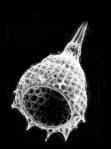


 |
Introduction & Morphology |
 |
Geological Application |
 |
Distribution in Space & Time |
 |
Glossary |
 |
Links |
 |
Home |
| | |
DISTIBUTION IN TIME & SPACE -pg 4.
The final extensive reoganization of radiolaria came in the Paleogene-Neogene transition. Several groups evolved and/or diversified at this transition, including the Tholonids, Antarctisins, Collosphaerids, Artiscins, Spongasterins, and Pyloni. The circumpolar water masses formed in the Neogene are thought to have been a factor in the evolution of the Tholonoids and the Antarctisins, since both are warm-water sphere forms. The development of nutrient-poor subtropical water masses provided a niche for the Collosphaerids, Artiscins, Spongasterins, and Pylonids, which are all warm-water sphere forms.

Image from F. Cordey's The Rad Page (see Links)

|

|
| Previous Page | Next Page |